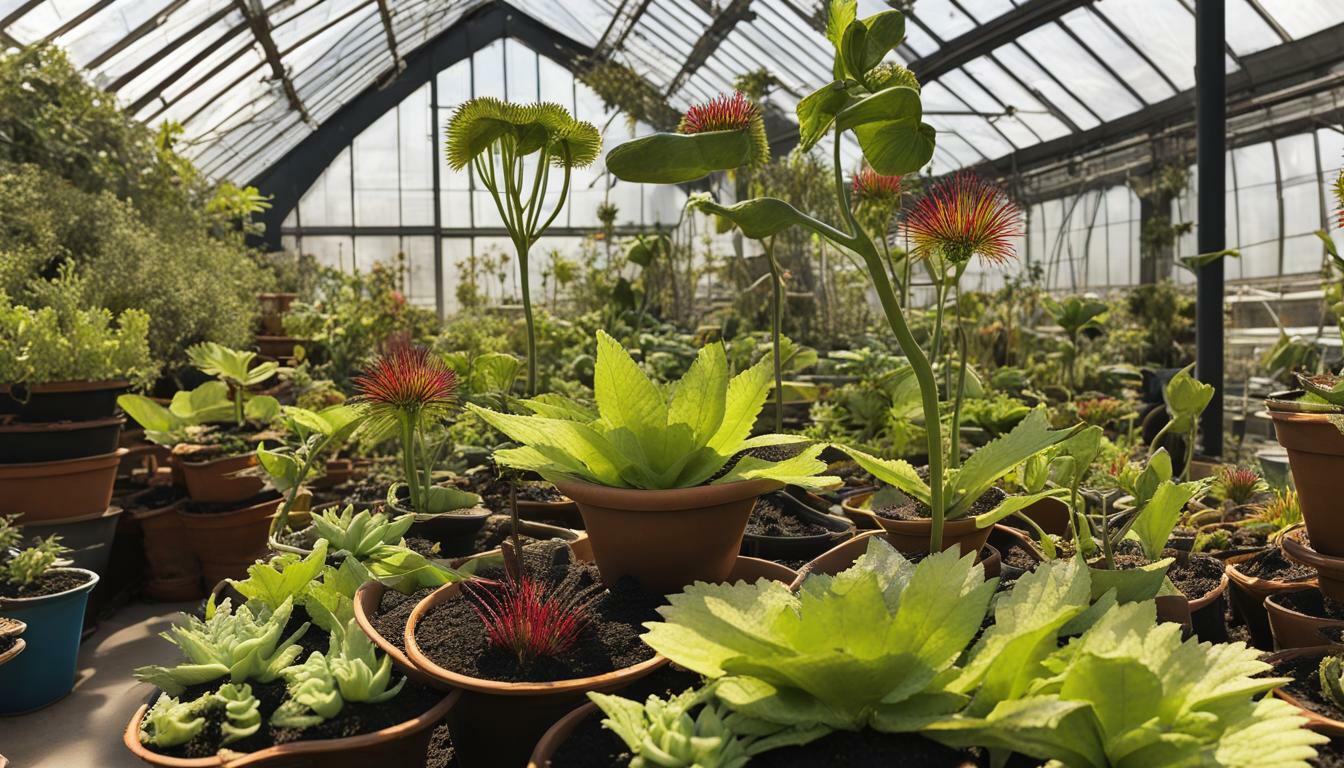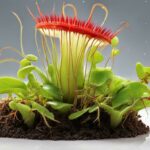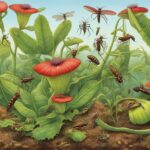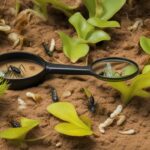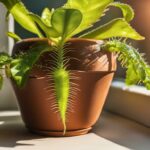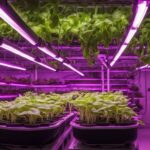As a Venus flytrap owner, seeing black leaves and traps can be alarming. It’s natural to wonder what could be causing this and if there is anything you can do to prevent it. The good news is that there are several possible explanations, and many of them can be addressed with proper care and attention.
It’s important to note that not all blackening of Venus flytrap leaves is a cause for concern. In fact, leaves naturally turn black over time as they reach the end of their lifespan. However, if you notice sudden or widespread blackening, mushiness, or other changes in the plant’s appearance and behavior, it’s worth investigating further.
Key Takeaways:
- Blackening of Venus flytrap leaves can be caused by several factors including overwatering, underwatering, insufficient light, high humidity, and feeding issues.
- Understanding the natural lifespan of Venus flytrap leaves can help avoid misconceptions about their color changes.
- Proper care and attention can prevent and address many causes of Venus flytrap leaves turning black.
Understanding Venus Flytrap Care
If you’re a proud owner of a Venus Flytrap, it’s important to know how to take care of it properly to ensure its health and longevity. Here are some tips to help you provide the best care for your carnivorous plant:
Growing Conditions
Venus flytraps thrive in moist, nutrient-poor soil and require plenty of sunlight. They’re native to subtropical wetlands in the southeastern United States, so they’re adapted to warm temperatures and high humidity. To replicate these conditions, make sure your plant is kept in well-draining soil and expose it to at least four hours of direct sunlight each day.
Watering and Feeding
Venus flytraps obtain most of their nutrients from insects, so it’s important to feed them regularly. However, they don’t require as much water as other plants because they conserve moisture in their traps. When watering, make sure to use distilled water or rainwater since tap water can contain minerals and chemicals that are harmful to the plant.
Potential Diseases
Venus flytraps are susceptible to diseases such as root rot and fungal infections. To prevent these issues, make sure to keep your plant’s soil well-draining and avoid overwatering. If you notice any signs of disease such as brown or black spots on the leaves, immediately isolate the affected plant to prevent spreading.
By following these tips, you can ensure that your Venus Flytrap remains healthy and happy. Remember to monitor your plant regularly and adjust its care as needed to keep it thriving.
Common Causes of Venus Flytrap Turning Black
It can be concerning to see your Venus flytrap leaves turning black, but understanding the possible causes can help you address the issue and prevent further damage. Below are some common reasons why your Venus flytrap might be dying and its leaves turning black:
- Overwatering: Too much water can cause the roots to rot, leading to blackening of leaves. Make sure you use distilled or rainwater and water the plant only when the soil is slightly damp. Avoid letting the plant sit in standing water as this can cause even more damage.
- Underwatering: On the other hand, not providing enough water can also cause blackening of leaves. Venus flytraps require moist soil, so make sure to water regularly and keep the soil damp but not waterlogged.
- Insufficient light: Venus flytraps need bright, direct sunlight to photosynthesize. Without enough light, the plant will weaken and its leaves may turn black.
- High humidity: While Venus flytraps do require some humidity, excessively high levels can cause fungal growth and blackening of leaves. Make sure to provide adequate ventilation to prevent mold growth.
- Improper feeding: Feeding your Venus flytrap incorrectly, such as with insects that are too large or too often, can cause damage to the plant and lead to blackened leaves. Stick to small, appropriate prey and only feed occasionally.
By understanding these common causes, you can address any issues your Venus flytrap may be experiencing and prevent further blackening of leaves. Keep in mind that a Venus flytrap’s leaves naturally turn black and die as part of their lifespan, so not all blackening is a cause for concern.
Overwatered Venus Flytrap: A Blackening Culprit
If your Venus flytrap is turning black, overwatering may be the issue. While it’s true that Venus flytraps require moist soil, they can suffer when exposed to too much moisture. Overwatering can lead to blackening of the leaves, traps, and even the entire plant.
The roots of the Venus flytrap can only absorb so much water, and excess water can lead to the roots rotting. Root rot is a fungal disease that can spread throughout the plant and ultimately lead to its death.
To prevent overwatering, ensure that your Venus flytrap is in well-draining soil and that the pot has drainage holes. Never allow the plant to sit in standing water, and always water with distilled water or rainwater. Avoid using tap water as it often contains minerals that can accumulate in the soil over time.
Check the soil frequently, but don’t water the plant until the top layer of soil feels dry to the touch. When watering, add enough water to fully saturate the soil, but avoid drenching the plant.
If you suspect that your Venus flytrap has been overwatered and is turning black, remove it from the pot and inspect the roots. If the roots are brown, mushy, and emit a foul odor, they have likely rotted. Trim away any dead roots, rinse the remaining roots with distilled water, and repot the plant in fresh soil.
When repotting, ensure that the plant is placed in a pot with drainage holes and that the soil is well-draining. Water the plant sparingly and avoid fertilizing it until it regains its health.
Remember, preventing overwatering is essential to ensure the health and longevity of your Venus flytrap. By implementing proper watering techniques, you can avoid blackening of leaves and traps, and maintain a flourishing plant.
Insufficient Light and Humidity: Impact on Venus Flytrap Health
Providing adequate light and humidity is crucial for the health of your Venus flytrap. Insufficient light can lead to stunted growth, weakened defenses against diseases, and decreased ability to catch prey. On the other hand, high humidity levels can create a breeding ground for harmful bacteria and fungi, which can cause rot and other diseases, ultimately leading to blackening of the leaves.
Ensure your Venus flytrap receives at least four hours of direct sunlight each day. If you keep your plant indoors, place it near a window that receives bright, indirect sunlight. If natural light is not enough, consider using artificial lights or grow lamps specifically designed for carnivorous plants.
Proper humidity levels are also essential. Avoid placing your Venus flytrap in an area with excessively high humidity, such as a bathroom or near a humidifier. Instead, aim for a humidity level between 50% and 60%. You can achieve this by placing a tray with pebbles and water under the plant, misting the leaves occasionally, or using a small humidifier.
Keep in mind that changes in light and humidity levels can cause stress for your Venus flytrap, leading to blackening of leaves. If you must move your plant to a new location, do so gradually over a few days, allowing it to acclimate to the new environment.
Feeding Issues: The Link to Blackened Venus Flytrap
Feeding your Venus flytrap can be tricky, and many mistakes can cause blackening of the leaves.
One common mistake is feeding your Venus flytrap too much too often. Overfeeding can cause a buildup of excess nutrients, leading to root damage and eventually blackening of the leaves.
On the other hand, underfeeding your plant can also lead to blackening. A Venus flytrap requires a consistent diet of live insects to stay healthy. Without sufficient nutrients, the plant will weaken and eventually die.
Another mistake many make is feeding their Venus flytrap prey that is too large. The plant has limited digestive abilities, and if the prey is too big, it can cause rot and blackening of the leaves.
Lastly, feeding your Venus flytrap the wrong types of insects can also cause issues. Avoid feeding it insects that are too tough, like beetles or hard-shelled insects. Opt for soft-bodied insects like flies or ants instead.
To avoid blackening of the leaves due to feeding issues, stick to a consistent feeding schedule with appropriately sized and easily digestible prey. This will help keep your Venus flytrap healthy and thriving.
Reviving a Venus Flytrap with Blackened Leaves
If you’ve noticed your Venus flytrap turning black or dying, don’t worry, there is hope! With the right care and attention, you can revive your plant and encourage new growth. Here are the steps to follow: 1. Assess your plant’s condition: Look for signs of blackening or wilting on the leaves or traps. If only a few leaves are affected, your plant might just need some adjustments to its care routine. However, if most of the plant is black or mushy, it might be too late to save. 2. Remove dead leaves: Using clean, sharp scissors, carefully trim away any dead or blackened leaves or traps. Be sure not to cut any healthy tissue, or you could harm the plant even more. 3. Adjust watering and feeding: Review your Venus flytrap care routine and make any necessary changes. Consider factors like watering frequency, the amount of light and humidity, and the type and amount of prey you’re feeding your plant. Over and underfeeding can lead to blackening of leaves. 4. Promote new growth: To encourage new growth, place your plant in a sunny spot with high humidity. Keep the soil moist but not waterlogged, and provide your plant with small insects or mealworms for food. Don’t overfeed the plant, though. 5. Be patient: Reviving a Venus flytrap with blackened leaves can take time. It might take a few weeks or even months to see progress, so be patient and consistent with your care routine. Remember, not all Venus flytraps can be saved. If your plant has been severely damaged or is beyond repair, it might be time to replace it. But with the right care, you can give your Venus flytrap a fighting chance and enjoy its unique beauty for years to come.Conclusion
As a Venus flytrap owner, it can be concerning to see your plant turning black. However, with proper care and attention, you can address the underlying causes and promote healthy growth.
We’ve explored the common reasons why Venus flytrap leaves turn black, such as overwatering, insufficient light and humidity, and feeding issues. By understanding these causes and implementing the appropriate solutions, you can prevent further damage and ensure your plant thrives.
Remember, a Venus flytrap’s leaves have a natural lifespan and will eventually die off. It’s essential to observe your plant and distinguish between natural color changes and signs of illness.
Continuing Your Venus Flytrap Care Education
To maintain a healthy and thriving Venus flytrap, it’s crucial to continue learning about proper care techniques and potential issues. The Venus flytrap is a unique and fascinating plant, and with proper care, it can provide years of enjoyment.
Continue to observe your plant and adjust your care techniques as necessary. With a little attention and dedication, your Venus flytrap will continue to thrive and delight for years to come.
Could Lack of Sunlight Cause My Venus Flytrap to Turn Black?
Could lack of sunlight cause my Venus Flytrap to turn black? Venus flytrap sunlight requirements are crucial for the plant’s survival. Without sufficient sunlight, the flytrap cannot undergo photosynthesis and may not be able to produce energy, leading to blackening of leaves. Ensuring it receives the required amount of sunlight is vital to maintain the vitality and health of your Venus Flytrap.
FAQ
Q: Why is my Venus flytrap turning black?
A: There can be several reasons why your Venus flytrap is turning black. It could be a natural part of the plant’s life cycle, or it could indicate an underlying issue. Common causes of blackening include overwatering, underwatering, insufficient light, high humidity, and improper feeding techniques.
Q: How can I prevent my Venus flytrap from turning black?
A: To prevent your Venus flytrap from turning black, it is important to provide the plant with the proper care. Ensure that you are watering it correctly, providing adequate light and humidity, and feeding it appropriately. Avoid overwatering, underwatering, and feeding with prey that is too large or too frequent.
Q: What should I do if my Venus flytrap has black leaves?
A: If your Venus flytrap has black leaves, it is important to assess the underlying cause. Check for signs of overwatering or underwatering, adjust watering techniques accordingly. Ensure that the plant is receiving adequate sunlight and humidity. Remove any dead leaves and continue providing proper care to promote new growth.
Q: Can I revive my Venus flytrap if it has blackened leaves?
A: It is possible to revive a Venus flytrap with blackened leaves, depending on the extent of the damage. Assess the plant’s condition, remove dead leaves, adjust care techniques, and provide optimal growing conditions. However, if the damage is severe or irreversible, it may be necessary to consider replacing the plant.
Q: How often should I water my Venus flytrap?
A: Venus flytraps require moist soil but should not be constantly wet. Ideally, water your Venus flytrap when the soil is slightly damp, and the top inch feels dry to the touch. Avoid overwatering, as this can lead to root rot and blackening of the leaves.
Q: Can my Venus flytrap survive indoors?
A: Yes, Venus flytraps can survive indoors if provided with the proper growing conditions. They require bright, direct sunlight for at least four to six hours per day. Additionally, maintaining a humidity level of around 50% and providing a well-draining soil mix are important for their overall health.
Q: Is it normal for Venus flytrap leaves to turn black and die?
A: Yes, it is normal for Venus flytrap leaves to turn black and die as part of their natural growth cycle. Each individual leaf has a limited lifespan, and as it reaches the end of its life, it will turn black and die. However, if most or all of the leaves are turning black, it could indicate a problem that requires attention.
Q: Can I feed my Venus flytrap meat?
A: Venus flytraps are carnivorous plants and rely primarily on insects for their nutrient needs. Feeding them small insects like flies or ants is recommended. It is not advisable to feed them meat, as it can be difficult for the plant to digest and may lead to issues such as rotting or blackening of the leaves.
Q: Can I use tap water to water my Venus flytrap?
A: Tap water can be used to water your Venus flytrap, but it should be free of chlorine and other harmful chemicals. If your tap water contains high levels of minerals, it is recommended to use distilled or rainwater instead. Avoid using water that has undergone water softening processes, as the salts can be harmful to the plant.

